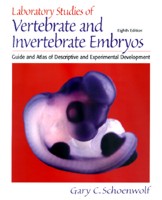Contents
- Preface iv
- 1 Sea Urchin Embryos 1
- 2 Frog Embryos, 23
- 3 Chick Embryos 51
- 4 Mouse Embryos 171
- 5 Pig Embryos 215
- 6 Hands-On Studies 279
- References 320
- History 322
- Credits 326
- Glossary 328
- Index 354
Preface
- Five major changes have been made in the eighth edition. First, a
new chapter (Chapter 4) has been added on the development of the mouse
embryo. With the advent of modern techniques in molecular genetics,
the mouse embryo has become an important model system for analyzing
development. Virtually any desired gene can now be mutated in the mouse
embryo, and the effects of its over expression or under expression can
be readily studied. Additionally, recent advances in whole-embryo culture
and techniques of experimental embryology have further increased the
importance of the mouse embryo to developmental biologists. With this
new chapter, we have added 69 photographs (Photos 4.1-4.69), 2 line
drawings (Figs. 4.1 and 4.2), and 2 experimental exercises (Exercises
4.1 and 4.2).
- Second, all images have been digitally processed. This was done to
improve quality, clarity, ascetics, and ease of viewing. All illustrations
have been relabeled and layout has been improved, with illustrations
from each chapter grouped together within the relevant chapter rather
than at the back of the book in a separate atlas. This should help the
student find and learn the material quicker. Aside from the new illustrations
added in Chapter 4, 28 additional illustrations (mostly scanning electron
micrographs) have been included in Chapters 2 and 3, increasing the
visual impact and depth of the manual. A new numbering scheme has been
used for all illustrations. Both photographs and line drawings are now
numbered according to chapter number (1-6) followed by a decimal point
and the number of the illustration in sequence. Photographs are referred
to as "Photos" and line drawings as "Figs."
- Third, the layout of the text was also done digitally. In doing this,
the text was reordered into 6 chapters, placed into two-column format,
and updated, and the flow from topic to topic has been simplified.
- Fourth, all exercises are now grouped together in Chapter 6, along
with additional hands-on studies. Seven new advanced hands-on studies
have been added, covering the cutting of frozen sections, in situ hybridization
(plus 12 new illustrations), chick New whole-embryo culture, dye injections
for tracking cell movements, BrdU labeling to study cell proliferation,
TUNEL labeling to study cell death (apoptosis), and mouse whole-embryo
culture. With the addition of 2 exercises on early mouse embryos, Chapter
6 now contains 22 exercises. These exercises allow students to gain
some hands-on experience with, and deeper appreciation for, living embryos
and the dynamic events underlying embryogenesis. Instructors may choose
to have students do all the exercises or only selected ones. Additionally,
instructors may choose to do all or some of the exercises as demonstrations
with various degrees of student participation. Furthermore, students
may consider doing selected exercises as independent study projects.
It is difficult to schedule experiments in a typical quarter or semester
course format when embryos develop over hours or days, and not all experiments
work every time. However, the pedagogic value of working with living
embryos far outweighs the scheduling difficulties. Also, although sometimes
experiments will fail, a failed experiment can often be more instructive
than a successful one, leading to subsequent inquiry into what went
wrong.
- Fifth, a glossary has been added. This will help students find definitions
quickly, facilitating their learning of important terms and concepts.
- This edition has been written to allow students to start their laboratory
studies with any of the organisms included, depending on the instructor's
preference. However, we do recommend that students study the chick embryo
prior to studying the mouse embryo; this will facilitate their understanding
of the "inverted" U-shaped mouse blastoderm as compared to the flat
chick blastoderm. Orientation illustrations ("orientators") are placed
with photographs to indicate the levels of the sections, slices, or
fractures illustrated. Unfortunately, it is not possible to indicate
the level of every section shown in the photographs: sections are closely
spaced and photographs are shown at a much higher magnification than
are the orientators; thus, insufficient room is available to demarcate
every section.
- In closing, let me encourage both faculty and students to send their
comments about this manual to me. Each new edition represents a stage
in the manual's evolution (see History), a stage that is largely determined
by the comments of users. To facilitate communication, you can contact
me at the following Email address: [email protected].
|

 SOCIETY FOR DEVELOPMENTAL BIOLOGY
SOCIETY FOR DEVELOPMENTAL BIOLOGY